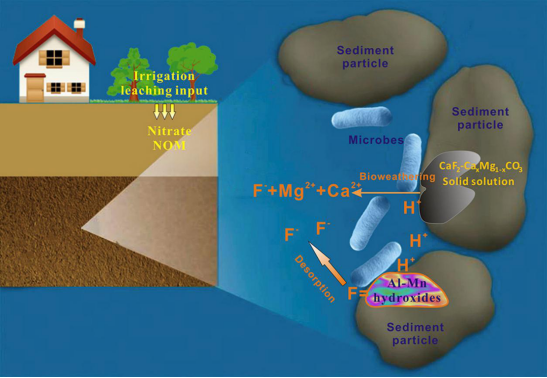“Impact of Anthropogenic Activities on the Enrichment of Fluoride and Salinity in Groundwater in the Yuncheng Basin Constrained by Cl/Br Ratio, δ18O, δ2H, δ13C and δ7Li Isotopes” is published inJournal of Hydrology (Volume 579, December 2019, 124211); “Indigenous Microbes Induced Fluoride Release from Aquifer Sediments” is published in Environmental Pollution (Volume 252, Part A, September 2019, Pages 580-590). The two papers are achievements of associate professor GAO Xubo’s team from the School of Environmental Studies.
Substantial concerns have been raised about the degradation of groundwater quality and their harmful effects due to salinization processes and endemic fluorosis issues in China. Yuncheng Basin is an economically important area situated in semi-arid northern China, which has suffered from severe groundwater contamination and intensive anthropogenic activities (agricultural, industrial and domestic). Twenty water quality parameters were surveyed at 85 groundwater and salt lake water sites during August 2013–September 2015. The combining using of Cl/Br mass ratio, δ2H, δ18O, δ13C, and δ7Li isotopes was employed to investigate the potential impact of anthropogenic activities which are supposed to contribute to groundwater salinization and fluoride enrichment in the Yuncheng Basin to a large extent. Results show that shallow groundwater are more vulnerable to contamination from anthropogenic processes of irrigation leaching, wastewater drainage, fertilizer utilization and Salt Lake water intrusion. Vertical irrigation recharge has been an important source of salt and fluoride for the shallow groundwater in the runoff area between Kaolao lowland and the central Basin, revealed by the high salinity (>4000 mg/L), high Cl/Br ratios (>2000), moderate high δ7Li (19.7–26.1‰), moderate δ13C (−8.1~−10.3‰) and constant δ18O and δ2H values. The contribution of over-utilization of fertilizers on high fluoride shallow saline groundwater is found in the crop land in the west part of the Salt Lake with a moderate high nitrate concentration (>10 mg/L), moderate Cl/Br ratios (332~1000) and low δ7Li value (13.8‰). Shallow groundwater in the northern part of the Salt lake polluted by wastewater, evidenced by boron concentration (>2000 μg/L), Na/K (molar ratio > 0.6), δ13C (−11~−11.1‰), and δ7Li (20.4~22.5‰), show highest fluoride concentrations. Due to over-pumping of groundwater, Salt Lake water intrusion mainly occurs in the northern shore of the lake and results in the enrichment of fluoride and salinity in some shallow groundwater with low Cl/Br ratios (around 300), high δ7Li value (c.a. 27‰), and moderate high δ18O (−8.2~−8.7‰) and δ2H (−62.2~−66.1‰) values. The influence of anthropogenic activities on deep groundwater is reflected in two possible scenarios. Increased extraction of groundwater leads to downward leakage of shallow high fluoride saline groundwater, increasing the pollution risk of deep groundwater within the depression cone in the west of Yuncheng City. The rapidly-developed drilling activities of geothermal water (δ7Li, 11~14.3‰; δ13C, −7.9~−8.4‰; [B], 709~3523 μg/L; [F], 2.1~8.2 mg/L) bring about the contamination of fresh groundwater by the underground leaking or discharge of geothermal water. Finally, a conceptual model has been developed to demonstrate the influences of anthropogenic activities on groundwater contamination along a northwest to southeast cross-section.

Release of fluoride from Quaternary sediments produces F-contaminated groundwater which threatens the health of millions of people worldwide. Despite the mechanisms of fluoride release from sediments are documented by numerous studies, it remains poorly understood that whether indigenous microbes participate in or not for the formation of F-rich groundwater by releasing fluoride from aquifer sediments. A microcosm-based approach, geochemistry and techniques of microbiology and molecular ecology were conducted together to investigate these mechanisms. Results show that microbes are abundant in high [F] groundwater containing at least 1129 operational taxonomic units (OTUs), and indigenous microbes can have an essential role in the mobilization of fluoride in sediments collected from aquifers in a typical fluorosis area in China. It also shows that for the sediments in this study, fluoride release (ca. 2 mg/L) is coupled with elevated concentrations of Ca (△ = 75 mg/L), Mg (△ = 33 mg/L), Al (△ = 0.2 mg/L) and Mn (△ = 1.4 mg/L). This suggests that the fluoride may source from the dissolution of F-bearing carbonate minerals and/or Al-Mn hydroxides in a local acidic environment. The findings provide additional insights into the biogeochemical circulation of fluoride in natural environment, especially in groundwater system and the development of effective strategies for the management of F-contaminated groundwater worldwide.

Title: Impact of Anthropogenic Activities on the Enrichment of Fluoride and Salinity in Groundwater in the Yuncheng Basin Constrained by Cl/Br R atio, δ18O, δ2H, δ13C and δ7Li Isotopes
Full Text: https://doi.org/10.1016/j.jhydrol.2019.124211
Title: Indigenous Microbes Induced Fluoride Release from Aquifer Sediments
Full Text: https://www.sciencedirect.com/science/article/pii/S0269749118355519